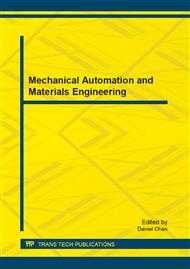[1]
Li X M, Research on Mechanical Property Simulation of Timber with Finite Element Method and Optimization of Timber, D, (2009), Inner Mongolia Agricultural University.
Google Scholar
[2]
Yang L Q, The Researches of Wood Libration Characteristic by FEM, D, (2008), Northeast Forestry University.
Google Scholar
[3]
Cui X Y, The Experiment Study on Wood Characteristic and the Number Simulation of Cutting Process, D, (2006), Beijing Forestry University.
Google Scholar
[4]
Tian J F, Study on the Cutting Properties of Caragana, D, (2007), Inner Mongolia Agricultural University.
Google Scholar
[5]
Luo J Y, Relationship between Log Mechanical Properties and Stress Wave Propagation Parameters, D, (2011), Northeast Forestry University.
Google Scholar
[6]
Zhao H, Study of Wood Bending Simulation by Ansys. Forestry Science and Technology, (2005) (1) 40-42.
Google Scholar
[7]
Zhang G L, Liu Z J, Li C H, Dynamic Simulation of Cut-in Process for Direct-tooth Cylindrical Wood Miller. Journal of Mechanical Transmission, (2010) (9) 53-55.
Google Scholar
[8]
Guo X R, Study on Virtual Simulation of Wood Cutting Process Based on Three-dimensional Model and Geometric Parameter Optimization for Wood Tool. Machine Tool & Hydraulics, (2009) (6) 25-28.
Google Scholar
[9]
Li M B, Modeling and Simulation of Wood Mechanical Properties Based on Finite Element Theory, (2007), Northeast Forestry University.
Google Scholar
[10]
Guo X R, Research on Parameter Optimistic Method and Experiment of Cutting Tool for Processing Woodblock in Paving Woodiness Ground, (2008), Northeast Forestry University.
Google Scholar
[11]
Zhang Z K, et al., Influence of Cutting Parameters on Cutting Forces in Wood Sawing. China Wood Industry, (2011) (3) 7-10.
Google Scholar
[12]
Zhang Z K, Influence of Cutting Direction on Cutting Forces in Wood, China Wood Industry, (2011) (6) 7-9.
Google Scholar
[13]
Su C, Finite Element Analysis of Metal Cutting Process Based on LS-DYNA, Journal of Northeastern University (Natural Science), (2008) (9) 1334-1337.
Google Scholar
[14]
Liu B, Li L, The study on the wood sanding force, Wood Processing Machinery, (2007) (6) 32-34.
Google Scholar


